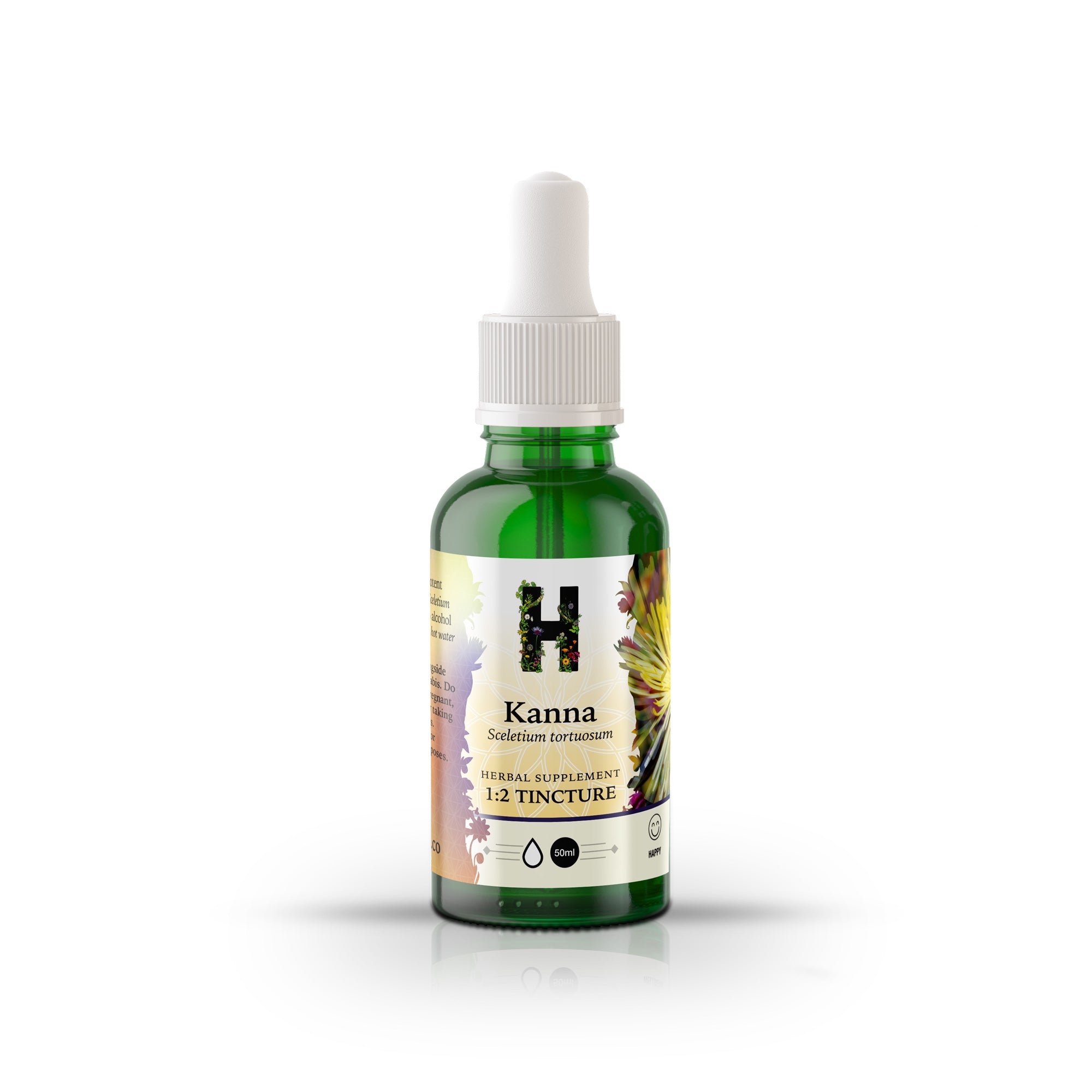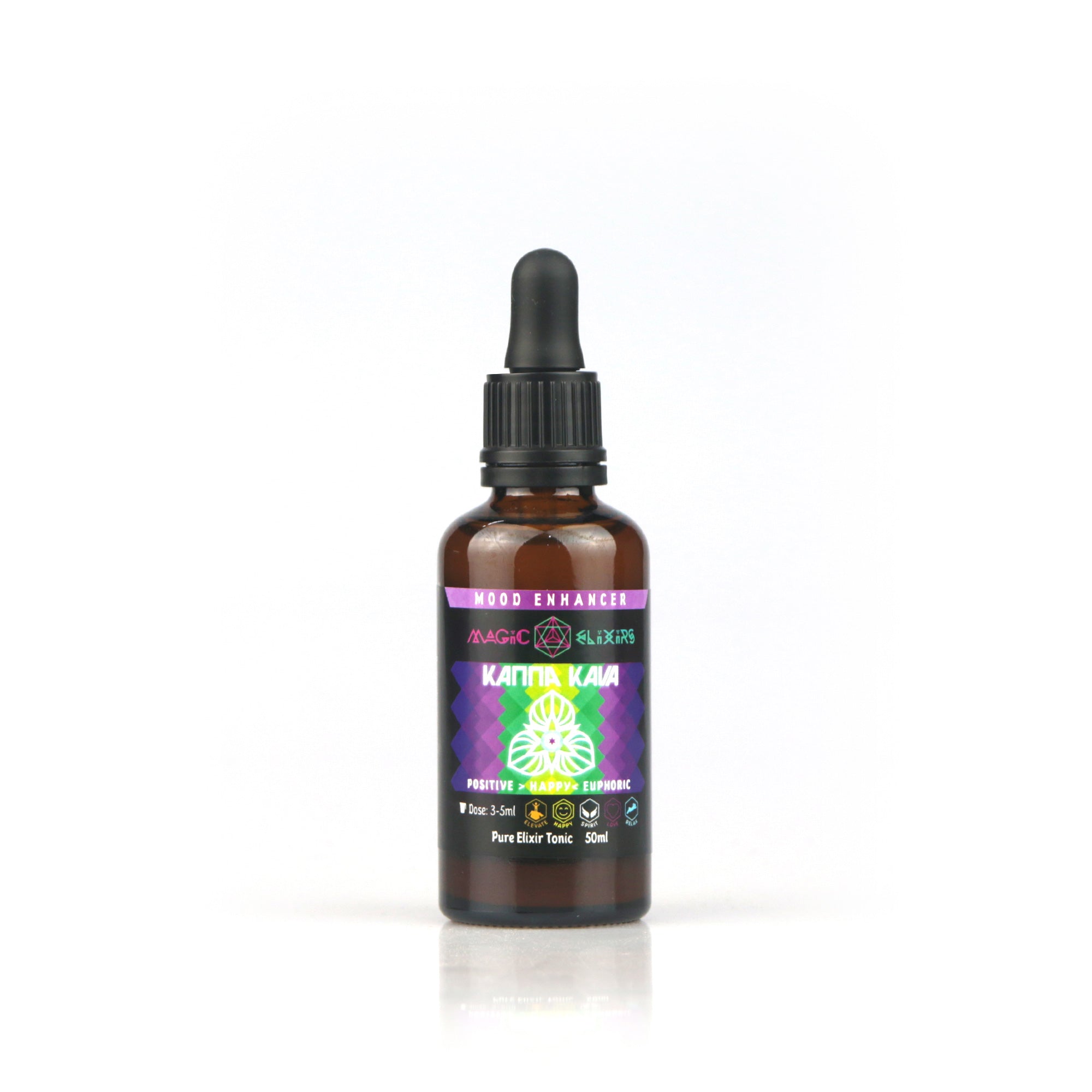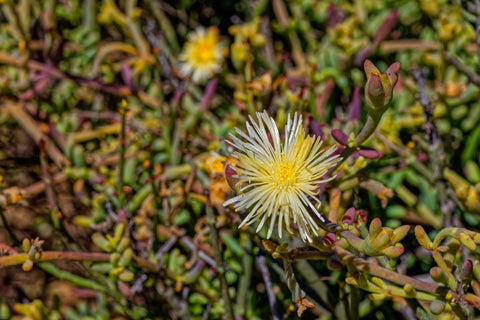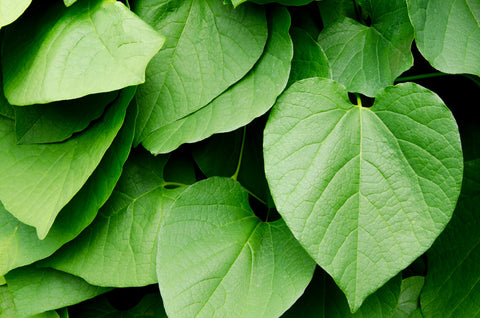
Botanical Name
Sceletium tortuosum
Also known as Sceletium, and Kougoed.
A succulent plant native to South Africa, Kanna has been used for centuries to enhance mood, relieve stress, and promote social connection.
Learn about Kanna
Kanna, also known as Kougoed or Sceletium, is a succulent plant native to South Africa that has been used by the Khoisan people for centuries to enhance mood, relieve stress, and promote social connection. Traditionally, the fermented plant was chewed as a ‘quid’, smoked, brewed into tea, or used as a snuff during social rituals, long hunts, and spiritual ceremonies. Today, Kanna is also available in the form of tinctures and extracts, and is gaining popularity as a natural support for stress, low mood, and mental fatigue.
The mood-enhancing effects of Kanna are due to a group of alkaloids, particularly mesembrine, mesembrenone, and tortuosamine. These compounds interact with the brain’s serotonin and dopamine systems. Mesembrine, the most studied of these alkaloids, acts as a serotonin reuptake inhibitor (SRI), increasing the availability of serotonin in the brain—similar to how many pharmaceutical antidepressants work, but typically with fewer side effects. Kanna also acts as a PDE4 inhibitor, which may contribute to its anti-anxiety, anti-inflammatory, and cognitive-enhancing properties.
Users report that Kanna can uplift mood, ease tension and anxiety, and support deeper emotional balance. Chewing or smoking it often produces a mild euphoria and heightened social openness, followed by a sense of calm relaxation. When brewed as tea or taken as a tincture, it provides a gentler, longer-lasting effect that can help reduce mental fatigue and support resilience in the face of stress. Some people also use Kanna to enhance meditation, creative flow, or emotional processing.
Modern clinical interest in Kanna has grown, with studies showing promising results in treating symptoms of anxiety, depression, and cognitive fog. In South Africa, Kanna extracts are sometimes used by psychiatrists and psychologists as part of integrative approaches to mental health. Anecdotally, it has also been reported to enhance the effects of other psychoactive herbs or practices, though care should be taken with combinations—especially with antidepressant medications, which may interact adversely with Kanna’s serotonin-modulating effects.
Whether used ceremonially, socially or simply to smooth out a stressful day, Kanna is a gentle yet powerful ally to uplift the mind and open the heart.
Frequently Asked Questions
Can I drink alcohol or take drugs with Kanna?
Can I drink alcohol or take drugs with Kanna?
Do not combine Kanna with alcohol, cannabis, or other drugs (especially antidepressants). Combining substances can increase the risk of adverse effects. Always use mindfully and in moderation.
How long do the effects of Kanna last?
How long do the effects of Kanna last?
The duration and onset of Kanna’s effects depend on the method of consumption:
Sublingual (under the tongue):
- Onset: 15–30 minutes
- Duration: 1–2 hours
- Often using fermented Kanna or extract held under the tongue for quick absorption.
Smoking or snuffing:
- Onset: Almost immediate (within minutes)
- Duration: 30–60 minutes
- Produces a short, sharp effect, often more stimulating.
Tincture (1:2 or similar):
- Onset: 15–45 minutes depending on dose and whether taken sublingually or swallowed.
- Duration: 2–4 hours
- Offers a balanced, full-spectrum effect — often calming, with mood lift and reduced anxiety.
Capsules or tea:
- Onset: 30–60 minutes
- Duration: 3–5 hours
- Slower and gentler, especially good for longer-lasting relaxation or emotional support.
Is Kanna addictive?
Is Kanna addictive?
No, Kanna is not considered addictive. It has no known habit-forming potential and is often used to support withdrawal from more addictive substances, such as cannabis or tobacco.
What are the best herbal alcohol replacements?
What are the best herbal alcohol replacements?
Here are some of the best herbal alcohol alternatives that offer mood-enhancing, calming, or euphoric effects without the hangover:
- Kava – Deeply relaxing and mildly euphoric; great for social anxiety and unwinding.
- Damiana – Uplifting, heart-opening, and slightly aphrodisiac; perfect for connection and joy.
- Blue Lily – Dreamy, calming, and subtly euphoric; ideal for ceremonies or slow, soulful evenings.
- Kanna - Uplifts mood, and promotes relaxation without sedation or intoxication.
- Lemon Balm – Calming and mood-brightening; gentle enough for daytime.
- Passionflower – Helps with social nerves and overstimulation; grounding and relaxing.
- California Poppy - gentle relaxation and mood support without sedation.
- Hops - gentle calming and mild sedation without intoxication.
What are the main effects of Kanna?
What are the main effects of Kanna?
Kanna is known for:
- Easing anxiety and stress
- Enhancing mood and sociability
- Improving focus and mental clarity
- Acting as a natural antidepressant. Its primary alkaloids (mesembrine, mesembrenone) inhibit the re-uptake of serotonin, so it is contraindicated with SRIs.
What's the difference between the Kanna Tincture and Kanna Resin?
What's the difference between the Kanna Tincture and Kanna Resin?
The main difference is in the concentration and how they are consumed. They have similar effects, but the method of consumption can affect how fast it is absorbed and takes effect.
The Kanna Resin is more concentrated, and can be taken in several ways - swallowed with water, dissolved in hot water or tea, or smoked with other herbs. Some people find smoking Kanna has a more immediate effect than swallowing or drinking it.
The Kanna Tincture is a full spectrum liquid plant extract, and the alcohol assists assimilation and absorption. Although it is less concentrated, we find it quite potent and recommend starting with only a few drops and building up from there.
When should I use Kanna as an alcohol alternative?
When should I use Kanna as an alcohol alternative?
Kanna is best used as an alcohol alternative when you want to feel uplifted, open-hearted, and socially relaxed without intoxication. It’s ideal for:
- Social gatherings where you want to feel more connected, talkative, and at ease
- Creative or emotional expression, such as music, art, or heart-to-heart chats
- Low mood or anxious days, when you need a boost in emotional resilience and presence
Kanna shines when you’re seeking gentle euphoria and emotional clarity. Use it in low doses to promote a calm, contented state—perfect for replacing alcohol in moments of connection or celebration.
Common Uses
Anxiety, Depression, Harm Reduction from Cannabis, Harm Reduction from Opiates/Alcohol, Mood Enhancement, Nervous System, Nicotine & Drug Withdrawal, Relaxation, Restlessness, Sexual Anxiety, Socialising, Stress, Tension, Tobacco Alternatives, Trauma (Emotional), Alcohol Replacement, and Spiritual Journeying.Precautions
Kanna is considered safe and non-addictive when used appropriately, though high doses can cause mild nausea or sedation. It should be avoided during pregnancy and breastfeeding, and by anyone taking SSRIs, MAOIs, or other serotonin-based medications. Do not combine Kanna with alcohol, cannabis, or other drugs. Combining substances can increase the risk of adverse effects. Always use mindfully and in moderation. This product is not intended to diagnose, treat, cure, or prevent any disease.
References
References
- Ray Thorpe, Happy High Herbs (2001), p 60.
- http://www.sceletium.org
- Harvey, A. L., et al. (2011). "Pharmacological actions of mesembrine-type alkaloids from Sceletium tortuosum (L.) N.E.Br." Journal of Ethnopharmacology, 137(3), 1124–1129.
- Smith, M. T., et al. (2018). "The potential pharmacological properties of Sceletium tortuosum: a review." Journal of Pharmacy and Pharmacology, 70(4), 475–489.
- Terburg, D., et al. (2013). "Sceletium tortuosum elevates mood and reduces anxiety in healthy volunteers." Journal of Clinical Psychopharmacology, 33(5), 643–647.
- Gericke, N., et al. (2020). "Sceletium tortuosum: an overview of current evidence and emerging applications." South African Journal of Botany, 130, 94–103.













